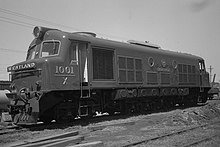WAGR X class
This article does not have any sources. (October 2023) |

The WAGR X class were a total of 48 diesel-electric locomotives operated by the Western Australian Government Railways (WAGR) from 1954 to 1988.
The X class were built by Beyer, Peacock & Coy of Manchester, England and Metropolitan-Vickers of Stockton-on-Tees, England from 1954 to 1956. Due to their light axle loads, they were immediately pressed into service around the entire network, they were allocated to express trains despite being designed for goods traffic. Their rigid frames made them rough riders, but because didn't require turning around they were still considered more efficient.
The engine used in the X class initially was untested and had various faults, issues and problems causing severe reliability concerns with resulting failures causing a Royal Commission into the matter which recommended the complete replacement of the X class. Midland Railway Workshops managed to continually repair, alter, and rebuild the X class to make them serviceable.
Some members of the class became the Xa class due to being fitted with twin/dual air (vacuum) braking. Withdrawals of the X class started in 1973, with the X class relegated to working grain trains on the South Western mainline in their dwindling years along with serving the Fremantle to Perth section of the Eastern Railway when it reopened. In 1988 the last of the X class was withdrawn.
One of the X class is preserved on display at the ARHS Rail Heritage W.A. Bassendean Railway Museum, and another five Xa class are also preserved.


